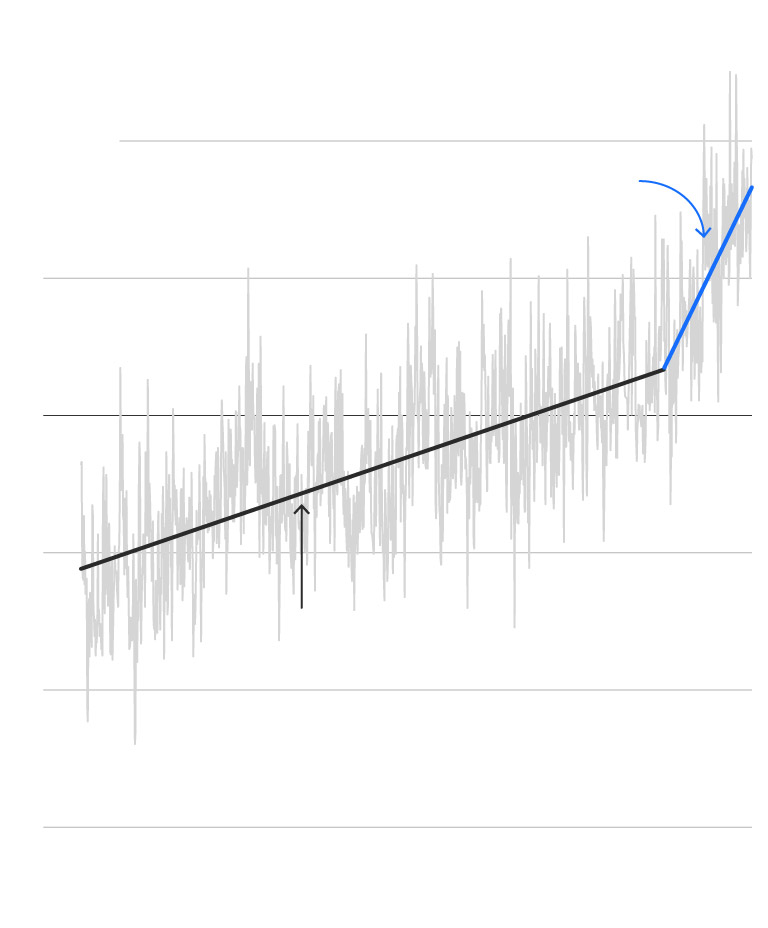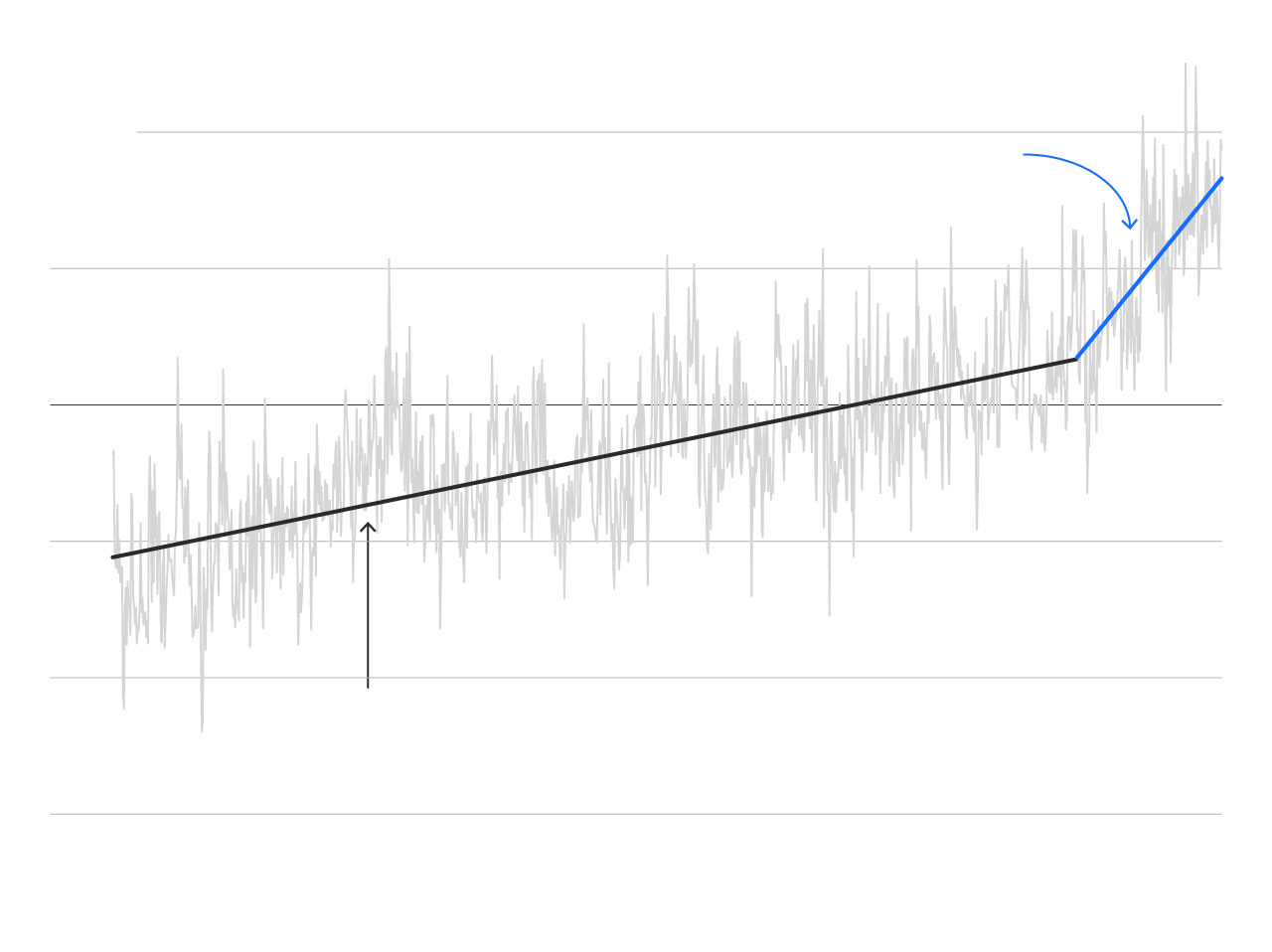The increase is already huge effects, the researchers found. One study Recent devastating hurricanes, including Michael in 2018 and Ian last year, suggest that they have been significantly worsened by rapidly rising seas. Federal tide gauge data According to the National Oceanic and Atmospheric Administration, sea levels in Lake Pontchartrain in New Orleans, as measured by tide gauges, are eight inches higher than they were in 2006 after Hurricane Katrina.
“The entire Southeast Coast and Gulf Coast are feeling the impact of sea level rise acceleration,” said Jianjun Yin, a climate scientist and author at the University of Arizona. One of Two Academic studies published in recent weeks detail the changes.
published in the journal Climate, calculates the rate of sea-level rise since 2010 10 millimeters – or one centimeter – per year in the region, Or a total of nearly 5 inches by 2022. This is more than double the global average rate of 4.5 millimeters since 2010. Satellite monitoring of sea level From experts at the University of Colorado at Boulder.
Although the annual amounts may seem small, even small changes in sea levels over time can have devastating effects. Yin’s study suggested that Hurricanes Michael and Ian, two of the strongest storms to hit the United States, were made somewhat worse by additional sea level rise.
“Water levels associated with Hurricane Ian were the highest on record due to the combined effect of sea level rise and storm surge,” Yin said.
A Second course A long list of sea level experts, led by Tulane University’s Sönke Dangendorf and published in Nature Communications, found a similar trend along the US Gulf Coast and Southeast coast since 2010, saying it was “unprecedented in at least 120 years.”
“It’s a window into the future,” said Tangendorff, who has collaborated with experts from several US companies and Britain’s National Oceanographic Centre. Rates have been so high in recent years, Dangendorf said, that they are similar to what would be expected under the highest greenhouse gas emissions scenario by the end of the century.
An extra Two studies Rapid sea-level rise and how it affects the region has been published by scientists in preprint but has yet to pass peer review, suggesting increased scientific attention to the subject.
The new findings are striking in part because the rapid rise is caused by deep changes in the ocean. In parts of Texas and Louisiana, land subsidence has long been a factor in the relative rise of sea levels over time. But in recent studies, scientists have found that the land is located in Pensacola and Cedar Key, Fla. shows that sea level is rising rapidly in places like Not sinking fast Places like Grand Isle, La., or Galveston, Tex.
In general, hurricane risks are few in the Gulf of Mexico and the oceans around Florida Highly exposed and storm prone Some parts of the US are still growing aggressively.
Additionally, as seas rise and people move to high-risk areas along coastlines, scientists say millions of acres of U.S. land and hundreds of thousands of homes and offices could slip below swell lines. Experts from the nonprofit First Street Foundation recently predicted that property values in many coastal areas could lose value as flooding intensifies, hurting homeowners and decimating local tax bases.
Scientists aren’t entirely on the same page about what causes this phenomenon or whether the recent acceleration in sea level rise will continue at such a rapid clip. Researchers generally prefer to rely on decades of data to be more certain about trends in the climate system and their causes. In that context, recent sea-level rise has occurred over a relatively short period of time. It obscures a worrying trend.
And yet, it seems so clear: The Sea levels in the Gulf of Mexico are beginning to rise rapidly. It’s getting hot Much faster than the world’s oceans. Warm water naturally expands and sea levels rise. That warm water is also carried by currents out of the Gulf and up the East Coast, affecting places like Georgia and the Carolinas.
Will this trend continue? That’s still unclear, scientists say.
The water in the Gulf of Mexico, which helped raise sea levels, is much warmer, even at deeper levels. Preprint inspection By Jacob Steinberg and colleagues at Woods Hole Oceanographic Institution, NASA’s Jet Propulsion Laboratory, the University of Hawaii at Manoa, and the National Center for Atmospheric Research.
Steinberg and colleagues suggest that this trend involves a warm current called the Loop Current entering the Gulf from the Caribbean Sea. This in turn is part of a widespread circulation in the Atlantic Ocean.
The warm loop current “brings water not just at the surface, but with depth,” Steinberg said. The current often extends hundreds of yards beneath the ocean’s surface, and Steinberg added, swirling bubbles of warm water that scientists call “eddies” move across the gulf.
Yin goes further in his study by linking this shift to the Loop Current, which he describes as the aftermath of a major deceleration event in the overall circulation of the Atlantic Ocean that occurred in 2009-2010. If true, this would suggest that these sea-level changes may be linked to a broader pattern that reflects how climate change is altering the circulation of the oceans.
Dangendorf, lead author of Nature Communications Study, not faith. While noting the same rapid sea-level rise in recent years as other works, his study determined a combination of factors, some of which are natural.
“We have this forced acceleration, but on top of that there’s that natural variability, and we’ve been unfortunate in the last couple of years that that acceleration has superimposed on the natural variability,” Tangendorff said.
Still, rapid sea-level changes are worrisome, Dangendorf said. The impacts are immediate, and similar to what scientists once expected only if the world were injecting massive amounts of planet-warming gases into the atmosphere.
Data from NOAA program Since 2000, “extreme tide flooding” along the Gulf Coast and Southeast coast has doubled, even on sunny days.
“It disrupts your daily life. It interferes with your daily life,” said Thomas Wall, a professor of coastal hazards and engineering at the University of Central Florida. and co-author of the Nature Communications article. “It destroys infrastructure. It corrodes vehicles that go through salt water every day. You can’t open your business or go to work.
It is true that in low-lying low-lying areas, even small sea-level rise can make storms more destructive. Waves move closer to shore, exacerbating erosion. The waves are pushed further inland. Wetlands can erode rapidly.
“Now you have a higher base water level,” Wall said. “If you have a hurricane now as opposed to the same hurricane 150 years ago, the impacts will be different.”
A Fourth course Scientists from the University of Miami, NOAA, NASA and several other institutions in the US and Australia found in preprint that the biggest rise in sea level in the Southeast since 2010 accounted for 30-50% of flood days in 2015. -2020.”
“In low-lying coastal areas, a rise in background sea level of even a few centimeters can break regional flood boundaries and lead to coastal flooding,” the study notes.
The key question is whether the current rates of change documented by the researchers will continue — leading to more than a foot of additional sea level rise in the coming decades — or whether they will return to levels more in line with the world. averages.

Rapid rise in sea level
Pensacola, Florida
2010−2022
1/2 inch per year
1923-2009
1/12 inch per year

Rapid sea level rise in Pensacola, Florida
2010−2022
1/2 inch per year
1923-2009
1/12 inch per year

Rapid sea level rise in Pensacola, Florida
2010−2022
1/2 inch per year
1923-2009
1/12 inch per year
Based on sea-level records from Pensacola and Galveston, which date back a century or so, the Gulf Coast also saw a rapid rise in sea level in the 1940s, which subsided in the 1950s. However, it is not yet clear whether this phenomenon will prove to be the case.
Overall rate of sea level rise Accelerating globallyAnd there are scientists Undoubtedly it was Even if humans drastically reduce greenhouse gas emissions, seas will continue to rise in the future.
In a report last year, NOAA and other federal agencies found that, on average, U.S. coastlines More feet are predicted to face rising seas over the next three decades. The report provided particularly high projections for the Gulf Coast, in significant part due to recent trends. Earlier this year, new research documented that the amount of excess heat buried in the planet’s oceans, a strong sign of climate change, reached a record again in 2022.
In the same report, NOAA detected If sea level rise along the eastern Gulf Coast continues on its recent trajectory, it could rival the high-level sea level forecast for 2050, NASA recently released. Sea level instrument These include similar findings that show seas are rising at rates that exceed even high-level forecasts at such sites. Pensacola, Fla., and Dauphin Island, Ala.
Although scientific debate is ongoing about the cause of current sea-level rise in the Gulf of Mexico and the US Southeast, the concrete effects it can impose on communities are likely to increase.
“It’s very difficult for me to say what’s going to happen in the future,” said Ben Hamlington, a NASA sea level expert and co-author of Steinberg’s study. “It doesn’t look like these rates are going to bounce back anytime soon.”